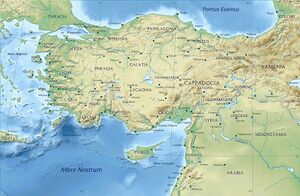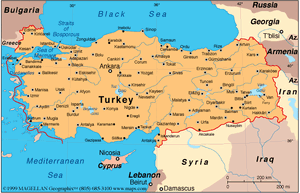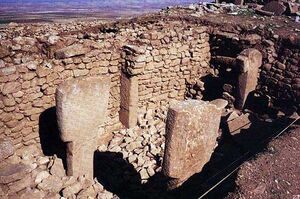Anatolia
| Author: Laxman Burdak, IFS (R). |


Anatolia, also Asia Minor, from Greek: Μικρά Ασία, mikrá asía) is a geographic region of Western Asia, comprising most of the modern Republic of Turkey.
Location
The region is bounded by the Black Sea to the north, the Caucasus to the northeast, the Armenian highland to the east, the Mediterranean Sea to the south and the Aegean Sea to the west. Anatolia is now often considered to be synonymous with Asian Turkey, its eastern and southeastern borders are widely taken to be the Turkish borders with the neighboring countries, which are Georgia, Armenia, Iran, Iraq and Syria, in clockwise direction.
Variants of name
- Asia Minor (Anabasis by Arrian, p. 53, 59, 76, 79, 108, 151, 278, 275, 276, 308.)
- Anadolu (Turkish)
- Anatolē (Greek Aνατολή)
Jat Gotras Namesake
History
Anatolia has been home to many civilizations throughout history, such as the Hittites, Phrygians, and Lydians, and Achaemenid, Greek, Armenian, Roman, Byzantine, Anatolian Seljuk and Ottoman states.
Anatolia has been inhabited by many peoples throughout history, such as the Hattians, Hurrians, Hittites, Luwians, Phrygians, Lydians, Persians, Greeks, Assyrians, Mitanni, Scythians, Cimmerians, Urartians, Carians, Commagene, Cilicians, Arameans, Kaskians, Mushki, Palaic, Corduene, Armenians, Romans, Colchians, Iberians, Georgians, Kurds, Laz, Zazas, Hamshenis, Sephardi Jews, Crimean Tatars, Karachays,Roma people, Circassians, Azerbaijanis, Seljuk Turks, Ottoman Turks and today predominantly modern Turkish people. Each culture left behind unique artifacts, still being uncovered by archaeologists.
Jat History
Ram Sarup Joon[1] writes that .... In 500 BC, Jats took part in the civil war in Italy. When the hunters invaded Italy, the Jats defeated them on the battlefield of Nester. As a reward the ruler of Italy permitted them to occupy the Danube basin called Balkans now. After four years, differences arose between the Jats and king Theodius of Italy,
History of the Jats, End of Page-41
who attacked the Jats. The Jats were victorious and occupied Asia Minor. Then they attacked Rome and after defeating the famous military commander Allers, occupied the south Eastern portion of Italy. Theodius gave his daughter in marriage to the Jat leader. The Jats vacated Italy, advanced into and settled in Spain and Portugal.
In 490 BC, there was another battle after which Jats occupied the whole of Italy and ruled there for 65 years upto 425 BC. During this period Italy made a great measure of progress.
Migrations from Indian to north western countries
Hukum Singh Panwar (Pauria)[2] writes that We may now cite at some length from Pococke[3] who has traced Indian migrations to all corners of the world solely through linguistic similarities. This extreme reliance on phonetic similarities seems to weaken his argument, but there is ample support, from other disciplines, techniques and lines of investigation, for his claims. Further, the large body of data, he has massed together cannot be brushed away lightly. When supported by other evidence, his thesis becomes incontrovertible. According to Pococke a great number of adventurous preux chevalier tribes from India migrated to Spain, Italy, Greece, Asia Minor,Persia, Colchis, Armenia and the Caucasus region, all of which provide distinct and startling evidence of Indian colonization in great profusio. We have tried (Appendix No.6) to pinpoint the Indian names and places of the origin of the migrated tribes as well as the altered forms of their names in their new settlements in other countries. The appendix indicating all this, is by no means, exhaustive. It may not be unnecessary here to point out that in some countries the presence of Indian tribes can be construed by their names, though distorted, while, in others their identity can be traced by place names in these transformed phonemic nomenclatures. All the more significant is the fact that almost all the tribes are considered Saca-Getae (Jats) or Scythians by the learned scholar[4].(cf. Appendix No.6).
Pococke[5] believes that the major migrations took place from India as a result of internecine wars and religious persecutions in which the Buddhists had been the main victims.
To these may be added the Parasurama-Haihayas (Scythians) wars, Sagar's war against Haihayas and their allies (Sakas, Parthas,Pahlavas etc) the Dasarajna Wars, the Rama-Ravana Yudha, the Mahabharata war. Pococke lays special stress on the virulent religious strife for a long time between the Brahmins and the Buddhists for supremacy, leading to Brahmanic victory and the gigantic expulsion of the Buddhists. Pococke claims[6] that this was the most crucial event which compelled migrations and
The Jats:Their Origin, Antiquity and Migrations:End of page 307
banishment of the vanquished to the north-western countries. The Saga of the Kurus and Pandus, though ostensibly political was in reality, as Pococke[7] contends, a struggle between the Brahminical and the Buddhistic parties. Profound night clouds this portion on Indian history. What Pococke regards as clear is that the emigrants coasted along the shores of Mekran, traversed the mouth of Persian Gulf. Adhering to the sea-board of Oman, Hadramant and Yemen (the Eastern Arabia), they sailed up the Red Sea, and ascending the mighty stream - the Nile - that fertilizes a land of wonders, founded the kingdoms of Egypt, Nubia, Abyssinia[8] and Ethiopia. Fhilostratus, Julius Africanus, Eusebius and Syncellus, the Greek writers[9] assert that the Ethiopians were originally an Indian race, emigrated from the river Indus and settled in the vicinity of Egypt. This assertion cannot be dismissed lightly.
After the death of the great Jat leader Totila, the Jat power declined and they were driven out of Italy. Soon after, the Arabs drove the Jats out of Spain and Portugal. Consequently Jats were so weakened and scattered that they ceased to exist as a recognised group in this area.
Hukum Singh Panwar (Pauria)[10] writes... The Indo-Aryan had colonised Anatolia and established the Vedic culture there (Nevali Cori) in 7300 B.C After them the Getae (5000 B.C.), the Panis or Punis or Phoenicians (3500 B.C.) and others went to Europe via Middle East, Asia Minor or Anatolia . The Indo-Aryans tribes migrated to the western countries as far as Scandanavia. On their way out they had intermittent stay and settlements, temporary or permanent, in suitable climes and countries. Orlova does not seem to have taken into consideration this significant factor.
Other names
In the Ancient Near East, Anatolia was not named as a single landmass. It was rather considered as consisting of separate countries, including
- Urartu, the Assyrian term for eastern Anatolia, in Biblical Hebrew Ararat,
- Hatti, the term for the part of central Anatolia delimited by the Halys bend, during the Hittite Empire period extended to the territory ruled by the Hittites,
- Arzawa, a confederation of states in western Anatolia, corresponding to classical Lydia,
- Lukka in southwestern Anatolia, corresponding to later Lycia,
- Kizzuwatna in southeastern Anatolia, roughly corresponding to later Cilicia
- Assuwa, a confederation of states in western Anatolia, likely the origin of the name Asia itself.
- Anatolia - The Greek name Aνατολή (anatolē) means "sunrise", viz. "the east", from the point of view of the Aegean, in reference to Greek Ionia. The name is thus in motivation equivalent to Latin "Levant" or "Orient" and Arabic "Mashraq".
- Asia Minor - The earliest extant, recorded appearance of the term Asia Minor is in about the year 400 by Orosius of Braga in his Historiarum Adversum Paganos Pauli Orosii Liber Primus.
अनातोलिया
अनातोलिया (तुर्की: Anadolu, यूनानी: Ανατολία) आज के तुर्की, ख़ासकर इसके मध्य भाग को कहते हैं। इसका पूर्वी भाग ऐतिहासिक रूप से अर्मेनिया तथा कुर्दिस्तान का अंग रहा है। यह इलाक़ा एशिया माइनर के नाम से भी जाना जाता हैं। सामान्य रूप से माना जाता है कि काले सागर के दक्षिण का भूभाग अनातोलिया है।
एशिया माइनर
दलीप सिंह अहलावत[11]लिखते हैं:
एशिया माइनर (लघु एशिया) - एशिया माइनर और यूरोपियन टर्की के राज खानदान को ओटोमेन कहते हैं।
ओटोमेन अपभ्रंश है यदुमनु का। तात्पर्य है यदुवंशियों से। (देखो दी पारसी रिलीजन जिन्दावस्था बाई जौन विल्सन डी० डी० ऐम० आर० ए० एस० पृ० 581)
खानदान ‘ओटोमेन’ जो इस समय कुस्तुनतनियां में राज कर रहा है। इसलिए एशिया माइनर वाले अपने को ‘जुडाह’ से मानते हैं। जुडाह अपभ्रंश है यदु का। (देखो दी पारसी रिलीजन जिन्दावस्था बाई जौन विल्सन डी० डी० एम० आर० ए० एस० पृ० 564)
जुडाहवंशीय ‘जुड्डास’ कहलाते हैं। उनको मुसलमान ‘यहूदी’ और यूरोपियन ‘ज्यूज’ कहते हैं। (देखो दी फौनटेन हेड ऑफ रिलीजन बाई गंगाप्रसाद वर्मा एम० ए० एम० आर० ए० एस०)। यहूदियों की तरह ईसाई लोग भी तौरेत को ईश्वरीय आज्ञा मानते हैं।
श्रीकृष्ण जी के उत्तराधिकारी एशिया माईनर में ‘सेमी’ तथा सेमीटिक्स कहलाते हैं। इन्हीं को मुसलमान ‘सामी’ कहते हैं। सामी अपभ्रंश है साम्बु का। तात्पर्य है श्रीकृष्ण जी के पुत्र
जाट वीरों का इतिहास: दलीप सिंह अहलावत, पृष्ठान्त-335
साम्बुवंशियों से (देखो टॉड राजस्थान)। श्रीकृष्ण जी की सातवीं पटरानी का नाम जाम्बुवन्ती था, जिसका ज्येष्ठ पुत्र साम्बु कहलाया। उसने सिन्ध नदी के दोनों ओर के देशों में अधिकार प्राप्त किया और खानदान ‘सीना-साम’ कायम किया, जिससे ‘जरेजा’ वंश की उत्पत्ति हुई। जरेजावंश के कविराजाओं का कथन है कि उनके पूर्व पुरुष शाम या सीरिया से आये थे। (ऐनल्स ऑफ जैसलमेर पृ० 1054) (पृ० 24-26)
एशिया माइनर के देशों में रहने वाले लोगों को मीडीज भी कहते हैं। मीडीज़ अपभ्रंश है मधु का। तात्पर्य है मधुवंशियों से (देखो टॉड राजस्थान अंग्रेजी)। मीडीज़ सम्राट् ययाति की सन्तान हैं (देखो श्रीमद्भागवत, पृ० 44)। आगे श्रीमद्भागवत, अध्याय 23, पृ० 70, श्लोक 28-29 में लिखा है कि यद्यपि वृष्णि और यदु के कारण से मधु का वंश माधव, वृष्णि और यादव इन तीन नामों को प्राप्त हुआ था, परन्तु वृष्णि ही इस वंश में श्रेष्ठ था (ये तीनों जाटगोत्र हैं)। ऊपरलिखित उदाहरणों से प्रमाणित हो जाता है कि एशिया माइनर के सब देश यदुवंशज, श्रीकृष्णवंशज या जाटवंशज हैं।
Jat History

Hukum Singh Panwar writes:[12] Our claim is further substantiated by unimpeachable evidence from another two latest archaeological sources. A controversy57 that racked the brain of scholars like Brandenstein, Gimbutas, Sauer, Issac and Ho as to where the centres of domestication of especially pigs and zebu cattle took place first, was silenced by Issae58, who, on the strength of the oldest archaeological evidence belonging to 7th millennium B.C. from the Near East, namely, Cayonu in Anatolia, asserts that domestication of pigs originated from Anatolia and the zebu cattle from India at a remote date. As mentioned elsewher the custom of milk-drinking was introduced by Nordic-Getaei in wstern countries probably as far back as 8000 B.C. This strengthens Issac's claim. Similarly, the evidence of Nevali Cori (Turkey) is still more revealing and strongly vindicates our stand. Dr. B.G.Sidharth59 informs us on the authorityd a highly developed civilization at Nevali Cori dating back to to 8th mil1ennium B.C. i.e. 7300 B.C.), that the discovery and study of a temple and a limestone head of a Vedic priest, complete with a clean shaven head and the Characteristic tuft of hair and pigtail, obviously proves that either the Rig-Vedic seers were the elite Anatolian class or had contact with them. This evidence affords a solid ground to Dr. Sidharth to fix 7300 B.C. as the date of Rig-Veda.
Hukum Singh Panwar writes:[13]
Again, Khattis (Khatri or Kshatriya), already identified173 with Getae, Skyth and Xatti or Khetas174 (Hittites of the Hebrews) and the Gutian, who are considered pre-Sumerian, also migrated to Mesopotamia 175. The French Savant, Francois Lenorment176 firmly attests that the Sumerians were definitely an Indian race who developed their culture in their home in the Indus Valley. Dr. Marshall177, the Danish archaeologist178, even Piggot179 and Woolley180 firmly corroborate the migrations of the Indian people from the Indus valley to Mesopotamian cities i.e. Babylon, Nippur, Uruk, Kish, etc. and their settling down there. The Cuneiform records181 of Mesopotamia, Syria and Anatolia also inform us that majority of people entering the Near East in the first half of the 2nd millennium B.C. are recognized as Indo-Aryans or simply Indians. Above all, the craniological evidence182, dental studies183 and ethnographical184 investigations, all suggest a common ancestry of the population from Rajasthan to Mesopotamia at the time of the Indus Valley civilization. This should be enough to warrant the
The Jats:Their Origin, Antiquity and Migrations: End of page 352
conclusion that illustrates our assertion. We can confidently conclude that our discovery of the Indus Guti (who were Goths or Jats) and the Mesopotamia Guti rulers are the same, and that the Indus Guti migrated to Sumeria, and not vice-versa.
Hukum Singh Panwar writes:[14] Several discoveries confirm the view that the people known as "Bull people" in ancient Europe and as "Bull worshipper" in Mesopotamia were Rigvedic tribes who emigrated to those lands after the Dasarajna wars via north Pontus and Middle East. Among these are the discoveries of the remains of domesticated Zebu cattle of Indian origin, barley (yava from Yavayavati?) and wheat, the original cereals of Sapta Sindhu and staple food of Rig Vedic people, in the Belt Caves near Caspian Sea by Gordon Childe and Carlton S. Coon, dating 8160 B.C.; the discovery of a statue of Rig Vedic rishi and a temple, dating 7300 BC, at Nevali Cori in Anatolia (Asia Minor or Turkey) by Dr. Heuptmann; the discovery of agricultural implements in Western Germany, Sweden and Jutland, attributed to Suevis (Sivis) and Juts, dating 4th and 3rd millennium B.C., highlighted by Prof. Graham Clarke and the discovery of motifs of Indian bull in various forms, brought to surface by Bedrich Hrozny, Bridget and Raymond Allchin besides Pierbe Amiet etc. at various sites in Mesopotamia, dating 4th and 3rd millennium B.C. (details infra).
External links
References
- ↑ Ram Sarup Joon: History of the Jats/Chapter III, p.41
- ↑ The Jats:Their Origin, Antiquity and Migrations/The identification of the Jats, pp.307-308
- ↑ Pococke, E; India in Greece, Indian Reprint, 1972, p. 32, 47, 134.
- ↑ Ibid., pp.38, 51ff, 63, 70, 124, 148, 159, 178, 195, 205, 229, 242, 251, 255,300.
- ↑ For further study please cf. C. Wordsworth, D.O., 'Greece, Pictorial and Descriptive; Grote, His. of Greece; Niebuh" His. of Rome; Troyer, Ramayana; Tod, Ann; Is and Antiquities of Rajasthan; Ency. Metropolitania; Smith, Muth. Lex., vol.I Homer, Odessey, Iliad; Asiatic Researches; Mure, His. of Greek Literatura, . Vol.I; Strabo's Geographia; Wilson, skt. Les.; Kruse, Hellas; Smith, Dic. of Astiq.; Hamilton E, Ind. Gaz., Vol.I; Thoronton, Geog. of Ph.; Thirliwall, His. of Greece; Thueydide, Genesis and App. No. XX in Pococke's Ind. in Greece
- ↑ Ibid., Chs VI-XV
- ↑ Ibid., p. 300. Dr. Buddha Prakash describes the Epic war as the 'Saga of the Sakas'.
- ↑ Ibid., p.43
- ↑ Ibid., p. 205.
- ↑ Hukum Singh Panwar (Pauria): The Jats:Their Origin, Antiquity and Migrations/The migrations of the Jats to the North-Western countries,p.258
- ↑ जाट वीरों का इतिहास: दलीप सिंह अहलावत, पृष्ठ.335-336
- ↑ The Jats:Their Origin, Antiquity and Migrations/The migrations of the Jats to the North-Western countries, pp.244
- ↑ The Jats:Their Origin, Antiquity and Migrations/Jat-Its variants, pp.352-353
- ↑ The Jats:Their Origin, Antiquity and Migrations/The migrations of the Jats to the North-Western countries , p.229
Back to Jat Places

